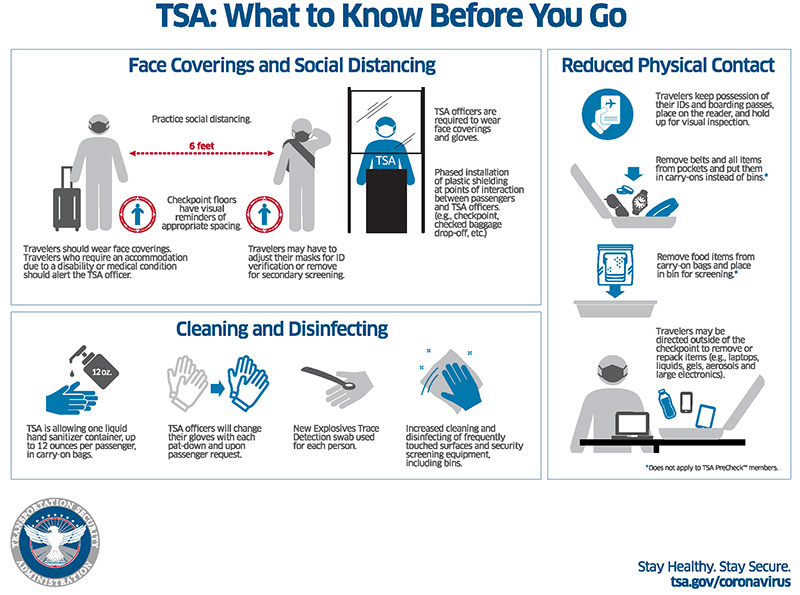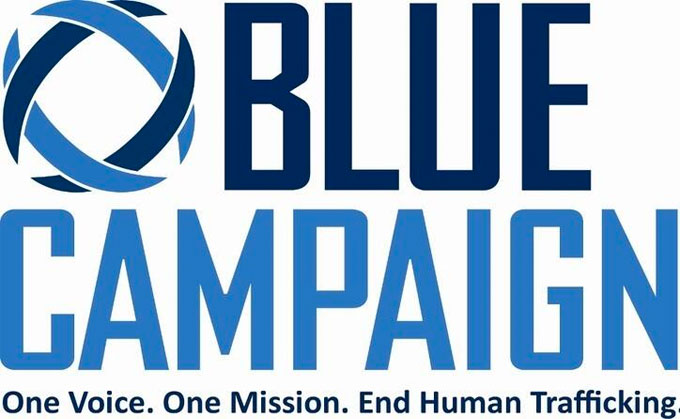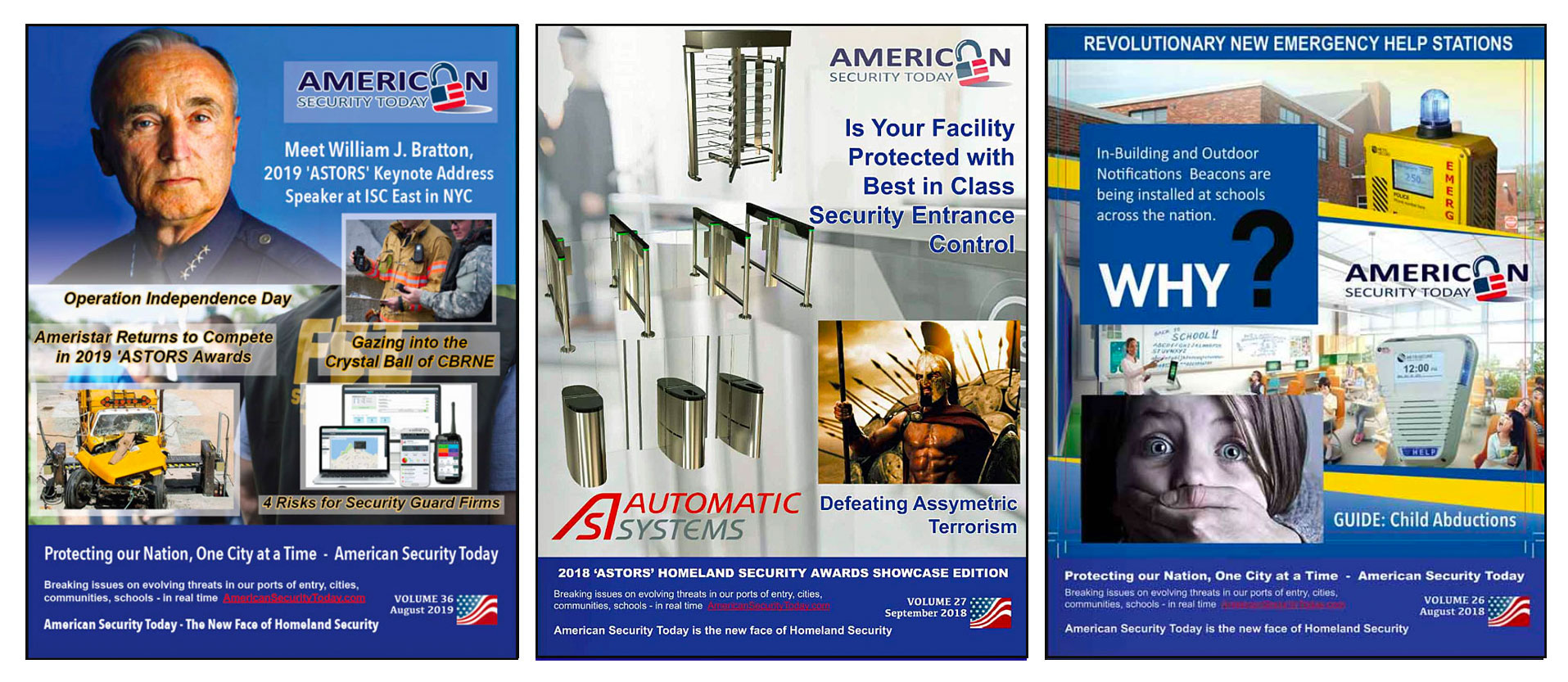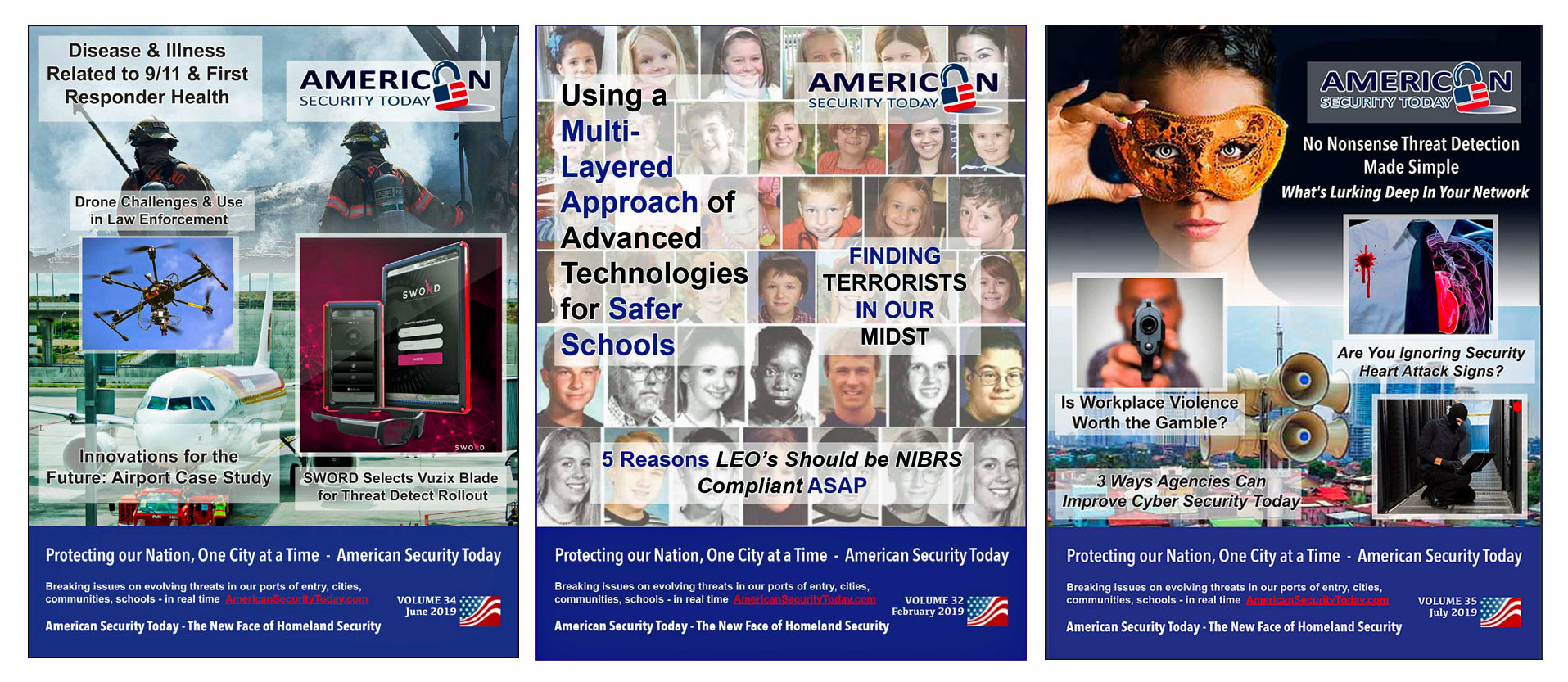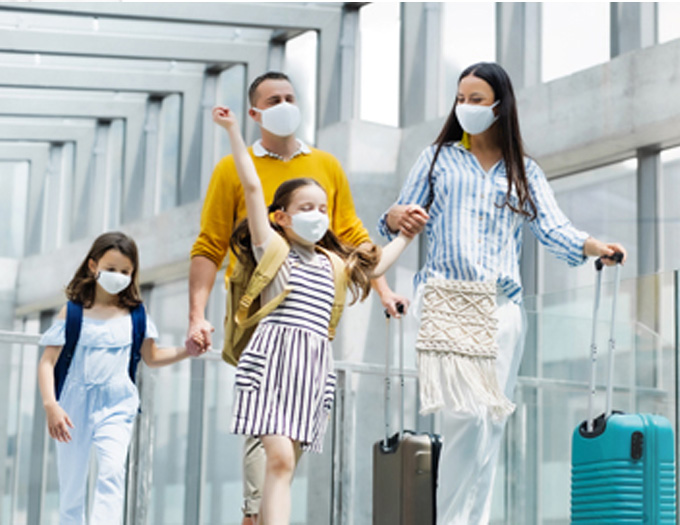
Although official advice from the Centers for Disease Control and Prevention (CDC) recommends delaying travel where possible (unless you’re fully vaccinated), and in accordance with state and local recommendations – Domestic flights in the USA are back in action, so here are the travel rules American domestic travelers need to know in order to can stay safe and protect others too.
Face Masks Now Required
The Transportation Security Administration (TSA) has implemented the Executive Order on face masks at airport security checkpoints and throughout the transportation network.
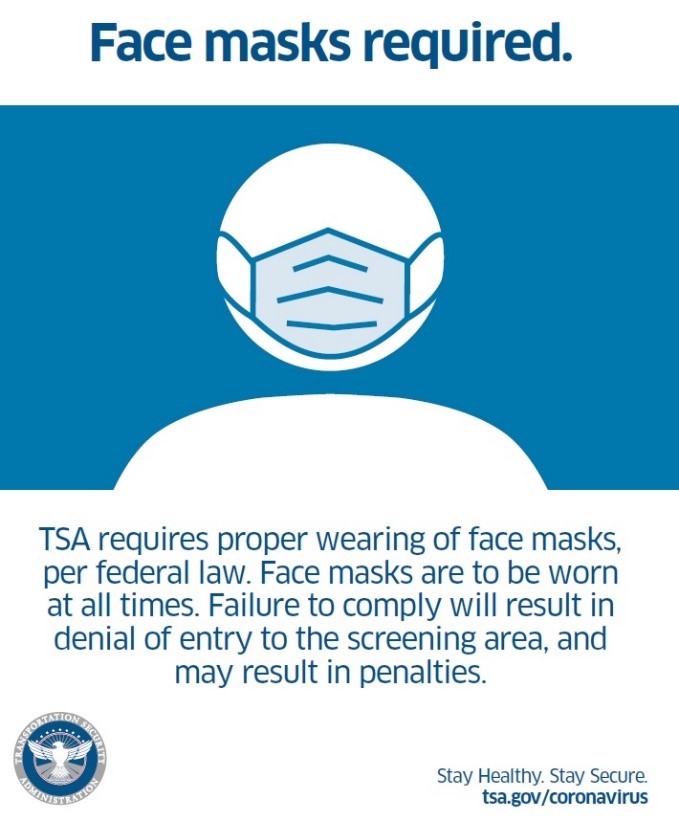
The TSA has extended the face mask requirement for individuals across all transportation networks throughout the United States, including at airports, onboard commercial aircraft, on over-the-road buses, and on commuter bus and rail systems through September 13.
“The federal mask requirement throughout the transportation system seeks to minimize the spread of COVID-19 on public transportation,” said Darby LaJoye, the Senior Official Performing the Duties of the TSA Administrator.

“Right now, about half of all adults have at least one vaccination shot and masks remain an important tool in defeating this pandemic.”
“We will continue to work closely with the Centers for Disease Control and Prevention (CDC) to evaluate the need for these directives and recognize the significant level of compliance thus far.”
The CDC recently announced that fully vaccinated travelers with an FDA-authorized vaccine can travel safely within the U.S., but CDC guidelines still require individuals to wear a face mask, socially distance, and wash their hands or use hand sanitizer.
Stay Healthy. Stay Secure.
TSA launched the “Stay Healthy. Stay Secure.” campaign, which details proactive and protective measures we have implemented at security checkpoints to make the screening process safer for passengers and their workforce by reducing the potential of exposure to the coronavirus.
The campaign includes guidance and resources to help passengers prepare for the security screening process in the COVID environment.
Travelers are reminded to follow the Centers for Disease Control and Prevention (CDC) travel guidance as well as local and state advisories regarding COVID-19.
Starting February 2, 2021, all airline travelers must wear a face mask throughout the travel experience. You will be asked to adjust your mask for ID verification or if it alarms the security screening equipment.
Travelers are also encouraged to:
-
Maintain a social distance of six feet wherever possible while at the checkpoint.
-
Remove belts and all personal items from your pockets such as wallets, keys or phones before you enter the checkpoint queue and place them in your carry-on bag. (Does not apply to TSA PreCheck® members).
-
Remove food items from carry-on bags and place in bin for screening. (Does not apply to TSA PreCheck® members).
-
Practice good hygiene, such as washing your hands regularly, including directly before and after completing the security screening process. If it is not possible to wash your hands, please use hand sanitizer.
-
Arrive at the airport early to allow adequate time for checking bags, completing security screening and getting to the departure gate. COVID-19 has affected staffing and operations across the airport environment, potentially adding time to your pre-flight experience.
Employees or travelers who believe they may have been in contact with a person who has COVID-19 should consult with their healthcare provider.
Employees or travelers who have tested positive for COVID-19 should seek medical attention and follow the guidance of their healthcare provider and local health department.
Security Checkpoints
While security is TSA’s top priority, the health and safety of their employees and the traveling public is of utmost importance to us.
TSA remains in close communication with medical professionals, the CDC, and various government agencies as we continue to carry out their important mission.
Below are some adjustments TSA has made at security checkpoints to make the security screening process safer.
Social Distancing
TSA has implemented procedures to increase social distancing and
reduce direct contact between their employees and the traveling public whenever possible – without compromising security.

Adjustments include increasing distance between passengers as they enter the security checkpoint queue and throughout the screening process, placing visual reminders of appropriate spacing on checkpoint floors, and opening more checkpoint lanes where possible to reduce time spent in line.
Reduced Physical Contact

TSA is implementing a phased installation of acrylic barriers at various points throughout the checkpoint that require interaction between passengers and TSA officers.
Travelers should keep possession of their boarding pass, place it on the document scanner and show the boarding pass to the TSA officer for visual inspection while at the travel document checking station.
Personal Protective Equipment

TSA officers are required to wear face mask and gloves.
They may also choose to wear eye protection or clear plastic face shields.
In addition, TSA officers change their gloves following each pat-down and upon passenger request.
Cleaning and Disinfecting

TSA has increased the frequency and intensity of cleaning and disinfecting of frequently touched surfaces throughout the checkpoint including security screening equipment and bins.
TSA officers are also required to change Explosives Trace Detection swabs after each use.
Medical Exemption for Hand Sanitizer

As a temporary exemption from the 3-1-1 rule, TSA is allowing one oversized liquid hand sanitizer container, up to 12 ounces per passenger, in carry-on bags.
Since these containers exceed the standard allowance typically permitted through a checkpoint, they will need to be screened separately. This will add some time to your checkpoint screening experience.
Please keep in mind that all other liquids, gels and aerosols brought to a checkpoint continue to be limited to 3.4 ounces or 100 milliliters carried in a one quart-size bag.
Click to Learn More about TSA’s special procedures for traveling with medication.
Touchless Technology
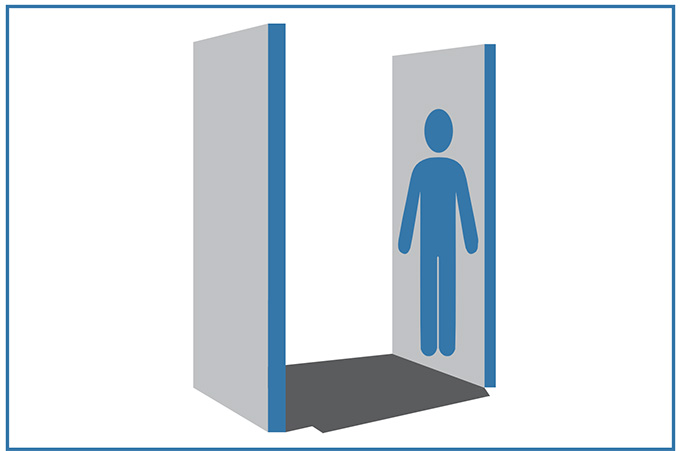
New technology continues to be a major priority for TSA.
Here are just a few examples of technologies that are changing the way we do business:
-
Computed Tomography (CT) produces high-quality, 3-D images for a more thorough visual analysis of a bag’s contents.
-
Enhanced Advanced Imaging Technology (eAIT) safely screens passengers without physical contact for threats such as weapons and explosives, which may be hidden under a passenger’s clothing.
-
Credential Authentication Technology (CAT) machines automatically verify identification documents presented by passengers during the security screening process.
Expired Driver’s License and REAL ID Extension

If your driver’s license or state-issued ID expired on or after March 1, 2020, and you are unable to renew at your state driver’s license agency, you may still use it as acceptable identification at the checkpoint.
TSA will accept expired driver’s licenses or state-issued ID a year after expiration. DHS has extended the REAL ID enforcement deadline to October 1, 2021.
To Learn More about REAL ID on TSA’s REAL ID webpage.
TSA PreCheck®
 TSA PreCheck® benefits are even more valuable in today’s travel climate.
TSA PreCheck® benefits are even more valuable in today’s travel climate.
TSA PreCheck passengers spend less time waiting in line and keep their shoes, belts and jackets on during screening and laptops, 3-1-1 liquids and food in their carry-ons, reducing overall contact during screening.
Visit TSA PreCheck to learn more.
Airport Closures and Flight Cancellations
TSA does not make decisions about flight cancellations or airport closures.
These decisions are made locally, on a case-by-case basis, by individual airlines, airports and public health officials. Before traveling, passengers should check with their airline and airports of origin and destination for the latest information on closures and cancellations.
Supporting our Workforce
The health and safety of their frontline workforce is paramount to TSA.
In addition to the measures taken to protect their frontline workforce from COVID-19 transmission, TSA is also using unique authorities to provide them with the additional support and care they deserve during this unprecedented time.
This includes:
-
Granting paid administrative leave or excused absences (rather than requiring use of personal leave) for those who are diagnosed with COVID-19, need to self-quarantine while awaiting a COVID-19 test result, or have had direct contact with an infected individual.
-
Providing for the maximum use of telework to promote social distancing.
-
Affording new protections and alternatives to employees who are members of vulnerable populations to fit their individual situations.
TSA will continuously evaluate and adapt their procedures and policies to keep their workforce safe as we learn more about this devastating disease and how it spreads.
TSA Nominated for Excellence in 2021 ‘ASTORS’ Awards Program
 American Security Today’s ‘ASTORS’ Homeland Security Awards program is now in its Sixth Year and continues to recognize the Outstanding Innovations of top firms and agencies in the Homeland Security and Public Safety fields.
American Security Today’s ‘ASTORS’ Homeland Security Awards program is now in its Sixth Year and continues to recognize the Outstanding Innovations of top firms and agencies in the Homeland Security and Public Safety fields.
2020 was a very challenging year for everyone due to the COVID-19 pandemic and the much heralded AST ‘ASTORS’ Awards Winners Presentations and exclusive Luncheon at the Jacob Javits Center in NYC had to be canceled and rescheduled for 2021 due to the virus.

However, the 2020 ‘ASTORS’ Homeland Security Awards Program was again a huge success and many new categories were added including a section for COVID-19 Detection and Innovation.
2020 ‘ASTORS’ Excellence in Homeland Security and Government Award Recipients Include
U.S. Department of Homeland Security (DHS)

Excellence in Homeland Security
-
The Blue Campaign is a national public awareness campaign, designed to educate the public, law enforcement and other industry partners to recognize the indicators of human trafficking, and how to appropriately respond to possible cases.
-
Blue Campaign works closely with DHS Components to create general awareness training and materials for law enforcement and others to increase detection of human trafficking, and to identify victims.
-
Located within the Office of Partnership and Engagement, the Blue Campaign leverages partnerships with the private sector, Non-Governmental Organizations (NGO), law enforcement and state/local authorities to maximize national public engagement on anti-human trafficking efforts.
-
Blue Campaign’s educational awareness objectives consists of two foundational elements, prevention of human trafficking and protection of exploited persons.
Department of Homeland Security (DHS) Science and Technology (S&T) Directorate

Excellence in Homeland Security
-
The COVID-19 pandemic is a global threat with life and death consequences, the enormity of which many of us have never seen before.
-
It is also a scientific challenge in need of innovative solutions and S&T is using every tool at its disposal to join the fight; including harnessing the knowledge of it’s experts on technology deployments, international collaboration, scientific breakthroughs, and support for America’s frontline workers.
-
S&T has focused its efforts on laboratory research and providing valuable resources to inform the broader response community and help keep front line responders safe.
-
Highlights of S&T’s response efforts can be found in our Battling the Invisible Enemy report.
DHS S&T Chemical Security Analysis Center (CSAC)

Excellence in Homeland Security
-
CARD, a chemical synthesis and chemical informatics centric data system (e.g. boiling point, melting point, toxicity, or spectroscopic information) containing both unclassified and classified data, is accessible from a classified website maintained on a server hosted by the Department of Defense.
-
The website is available to appropriately cleared personnel from DHS, Department of Justice (e.g. FBI), other United States Government interagency offices, and state and local agencies, and provides information on how chemicals of interest could be produced.
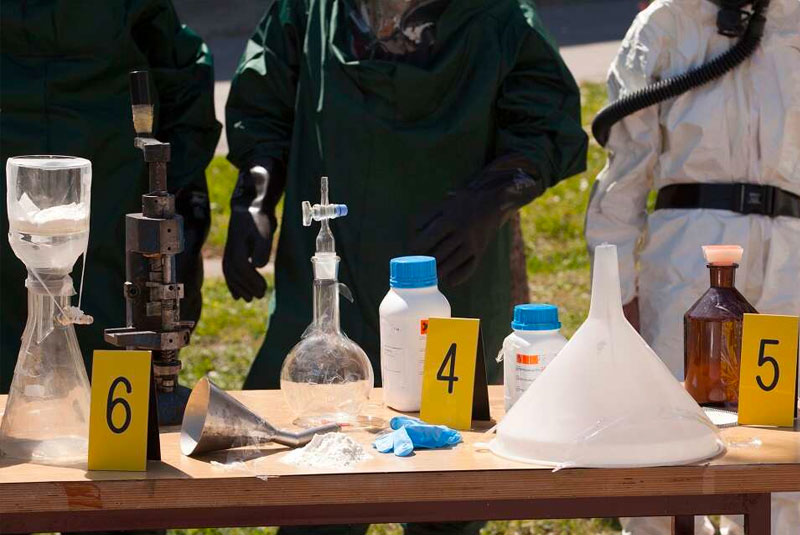
-
There is a detailed description of how each chemical is prepared to include information relevant to each step, the reagents and reactants that are needed and the conditions necessary for the reactions to take place, such as time, temperature, mixing—like a recipe.
-
If law enforcement were to discover a table full of labeled chemicals in a clandestine laboratory, they would put these names as a list in CARD to find out what the suspects are making – illicit drugs, poisons, or warfare agents.
-
CARD can be used the other way around. If police find an illicit drug or a warfare agent, they can search in the website to see what chemicals can be used to make it.
-
For example, if police capture a suspect with a vial of sarin gas (a nerve agent that can kill in minutes after inhalation), they can use CARD to determine which chemicals are used to make it. Police can then search the suspect’s illicit lab for those chemicals and obtain further evidence of wrongdoing.
DHS S&T National Urban Security Technology Laboratory (NUSTL)

Excellence in Public Safety
-
-
Hoist Rescue Gloves for Aerial Rescue
-
-
Rescue helicopter hoist operators need gloves to protect the hand that guides the hoist cable during rescue descents and ascents, using a significant amount of force to mitigate the cable swinging for situations from hurricane evacuations and dive rescues to rescuing stranded hikers on a mountain side, missions vary and no two are ever alike.
-
A partnership between S&T and Higher Dimension Materials, Inc. (HDM) resulted in an enhanced rescue hoist glove with increased flexibility, durability, and dexterity.
-
The glove design uses cushioning materials offering protection to the thumb crotch (purlicue) area, the index and little finger, and a leather guard to alleviate inconsistent glove performance when wet,” said Jones-Holt.
(See the enhanced Hoist Rescue Glove in action. Courtesy of DHS Science and Technology Directorate and YouTube.)
Department of Homeland Security (DHS) Science and Technology (S&T) Directorate

Excellence in Homeland Security
-
The Slash CameraPole is a self-triggering platform with wireless data retrieval to detect and give warning of suspicious activities at the U.S.-Canada border, specifically a cleared stretch of land at the border that is approximately 20-feet wide, 1,349 miles long, and is referred to as the “Slash.”

-
This man-made, treeless zone is mandated by the International Boundary Commission and presents a formidable surveillance challenge, against such threats as illegal crossings, drug and illegal contraband smuggling and human trafficking.
-
Using the Slash CameraPole system, Border Patrol has been able to establish an advanced border surveillance capability where none existed before.
-
Partnering with MIT Lincoln Laboratory and several private companies to create the Slash CameraPole with numerous ingenious features, such as solar panels and a back-up fuel cell system make it independent of the power grid, multiple infrared cameras (two long-range, one foreground, and one base imager with a fisheye lens) mean it doesn’t miss a thing.
-
An in-ground cement foundation and electrical enclosure ensures it can withstand brutal winter conditions. Should its unobtrusive appearance manage to draw the attention of would-be vandals, the Slash CameraPole is resistant to small arms fire and other tampering.
-
The Slash CameraPole also employs advanced motion detection algorithms and automated alerts designed to improve classification of targets and lower the chance of false alarms from factors such as wild animals or vegetation moving in the wind.
-
*DHS S&T Programs have now been recognized in their Fifth Annual ‘ASTORS’ Awards Program.
Centers for Disease Control and Prevention (CDC)

Excellence in Homeland Security
-
The CDC has provided Law enforcement and EMS who must make contact with individuals confirmed or suspected to have COVID-19 with guidance to help safeguard their health while performing their duties.
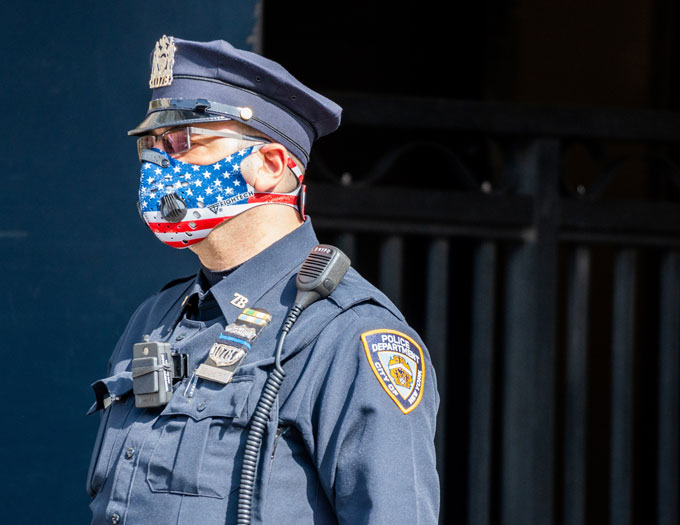
-
Different styles of PPE may be necessary to perform operational duties. These alternative styles (i.e. coveralls) must provide protection that is at least as great as that provided by the minimum amount of PPE recommended.
-
Law enforcement who must make contact with individuals confirmed or suspected to have COVID-19 should follow CDC’s Interim Guidance for EMS.
-
To Learn More, please visit the CDC’s answers to frequently asked questions about law enforcement and COVID-19 by clicking this link.
U.S. Immigration and Customs Enforcement (ICE)

Excellence in Homeland Security
-
ICE Enforcement and Removal Operations (ERO) is charged with enforcing the nation’s immigration laws in a fair and effective manner.

-
ERO identifies and apprehends removable aliens, detains these individuals when necessary and removes illegal aliens from the United States.
-
ERO transports removable aliens from point to point, manages aliens in custody or in an alternative to detention program, provides access to legal resources and representatives of advocacy groups and removes individuals from the United States who have been ordered to be deported.
-
ERO’s mission is to protect the homeland through the arrest and removal of aliens who undermine the safety of our communities and the integrity of our immigration laws.
Department of Justice (DOJ) Office of Personnel Management (OPM)

Best Federal Government Security Program
-
-
Federal Risk Management Process Training Program
-
-
The Federal Risk Management Process Training Program (FedRMPTP), Newly available Online – is Interagency Security Committee certified for Facility Security Officials, Federal Security Supervisors and those involved with Federal facility acquisition, construction, and renovation projects.

-
On October 19, 1995, six months after the Oklahoma City bombing of the Alfred P. Murrah Federal Building, President Clinton issued Executive Order 12977, creating the Interagency Security Committee (ISC) to address continuing government-wide security for federal facilities.
-
Prior to 1995, minimum physical security standards for non-military federally owned or leased facilities.
Federal Bureau of Investigation (FBI)

Excellence in Homeland Security
-
The IC3 serves as the FBI’s central hub to receive, develop, and refer criminal complaints regarding the rapidly expanding occurrences of Internet crime
-
IC3 provides the public with a reliable and convenient reporting mechanism to submit reports of suspected Internet-facilitated criminal activity and to develop alliances with law enforcement and industry partners.
(Actress Kirsten Vangsness, who plays tech-savvy FBI analyst Penelope Garcia on the show Criminal Minds, is promoteing the awareness of Internet crimes and scams and encourages the public to report suspected criminal cyber activity to the FBI’s Internet Crime Complaint Center (IC3). Courtesy of the FBI and YouTube.)
-
Information is analyzed and disseminated for investigative and intelligence purposes to law enforcement and for public awareness.
-
Since 2000, the IC3 has received complaints crossing the spectrum of cyber crime matters, to include online fraud in its many forms including intellectual property rights (IPR) matters, computer intrusions (hacking), economic espionage (theft of trade secrets), online extortion, international money laundering, identity theft, and a growing list of Internet facilitated crimes.
-
It has become increasingly evident that, regardless of the label placed on a cyber crime matter, the potential for it to overlap with another referred matter is substantial.
-
IC3 develops leads and notifies law enforcement agencies at the federal, state, local and international level.
Federal Protective Service in Collaboration with the Argonne National Laboratory

Best Risk, Crisis Management Solution
-
-
Modified Infrastructure Survey Tool (MIST) – COVID-19 Telematics Capabilities
-
-
DHS’s Federal Protective Service (FPS) provides integrated security and law enforcement services–including conducting security assessments and detecting and mitigating threats–to over 9,500 federal facilities. To accomplish this mission, FPS leverages the Modified Infrastructure Survey Tool (MIST), a joint solution developed in partnership with Argonne National Laboratory.

-
Argonne and FPS have continuously sought ways to improve the tool’s ability to assess, detect, and mitigating threats, and this year, no threat was more pervasive in this country than COVID-19.
-
To confront the threat that COVID-19 posed to the FPS workforce, MIST was enhanced to allow FPS Headquarters and FPS Management to track and display each federal building affected by COVID-19, and to analyze local hospitals and EMS facilities in relation to federal buildings and office locations.
-
Additionally, the map capability within MIST was expanded to allow for many additional layers, allowed FPS a granular understanding of the number of facilities impacted by the virus, and much more.
-
Ultimately, the new COVID-19 telematics capabilities offered FPS decision makers the ability to make better informed decisions on moving personnel and security equipment to best protect people and property, while ensuring safety of their staff.
-
The Federal Protective Service and Argonne National Laboratory have also been recognized in the 2019, and 20188 ‘ASTORS’ Awards Programs respectively.
-
To Learn More, please visit the DHS Federal Protective Service at https://www.dhs.gov/topic/federal-protective-service.
John Verrico

Excellence in Homeland Security
-
-
Chief of Media and Community Relations, DHS Science & Technology Directorate
-
-
John Verrico, who is also the former President of the National Association of Government Communicators, has nearly 40 years of experience as a public affairs professional in federal and state government agencies, working extensively in media, community and employee relations, with significant emphasis in science, engineering and the security fields.

-
A retired Navy Master Chief Journalist, John’s career has been focused on helping government agencies tell their stories and share important news with the public. He takes special care to ensure government information is accessible and that complex issues are easily understood.
-
John has also worked as a freelance journalist, stand-up comic, and motivational speaker, among other fields where he learned not to take life too seriously and to experience everything life has to offer.
-
As an under-sized youth and victim of bullies, John found hope in classic monster movies and ‘B’ flicks where he learned that the little guy could win. Drawing from these lessons, John helps every day unsung heroes get recognition for their work.
-
As an international speaker and leadership coach, John helps people keep their motivational torches lit so they can face their own ‘monsters.’
Kathleen Kiernan, Ed. D

Excellence in Homeland Security
-
-
Kiernan Group Holdings CEO
-
-
Dr. Kathleen Kiernan is the Founder and CEO of national security, education, risk management and compliance firm Kiernan Group Holdings, Chair Emeritus of InfraGard National Members Alliance, and adjunct faculty member at Johns Hopkins University and Naval Post Graduate School.

-
Preparedness without Paranoia® the experience-based training in awareness, preparedness, response and recovery training for active assailant and workplace violence prevention is delivered on a learning management system.
-
GOT Preparedness® (Got Online Training), was built specifically for dispersed and remote workforces and we have trained thousands of individuals domestically and internationally.
-
She has delivered operational and educational capabilities across the globe and developed a methodological based approach to the resiliency cycle at an individual and organizational level.
Joseph Pangaro

Excellence in Public Safety
-
-
CEO at True Security Design
-
-
As the owner and CEO of Pangaro Training and Management, Joseph Pangaro, concentrates on providing the best and most up to date training programs for the Law Enforcement, School and Business communities.

-
True Security Design (TSD) law enforcement training programs are centered around supporting today’s modern professionals’ by teaching them vital skills through courses designed to engage and empower its participants.
-
A 27-year veteran police lieutenant and experienced school security director, Lt. Pangaro is uniquely qualified to provide law enforcement training programs that are centered around supporting today’s modern professionals’ by teaching them vital skills through courses designed to engage and empower its participants.
-
Pangaro Training also teaches in police academies and police agencies throughout New York, New Jersey, and Pennsylvania.
New Jersey City University

Excellence in Public Safety
-
NJCU is one of the few programs nationally in higher education designated an Intelligence Community Center of Academic Excellence (CAE) per the Office of the Director of National Intelligence (ODNI) and a Cyber Defense CAE per the National Security Agency.

-
The Department of Professional Security Studies focuses on a student–centered, scholar-practitioner approach to education.
-
It’s mission is to facilitate access, create opportunities and provide a supportive environment for achieving academic success through learning and appreciation of subject matter, professional and personal growth and the development of identified and marketable global and disciplinary competencies.
-
The New Jersey City University (NJCU) Cybersecurity program is an interdisciplinary center for cybersecurity education, training and research, which aims to provide current and future professionals with the knowledge and skills necessary to strive and compete within the cyber security community outreach.
-
NJCU students’ foundation is built through their degree program, certificates and research opportunities.
New York City Emergency Management

Excellence in Homeland Security
-
-
New York City Emergency Management (NYCEM), is under the guidance of Commissioner Deanne Criswell, a former FEMA official and head of OEM for the city of Aurora, CO, who is responsible for oversight and development of the city’s emergency management plans.
-
NYCEM regularly tests plans by conducting drills and exercises, and responds to emergencies to ensure that other agencies not only follow these plans, but to foster communication amongst the responding agencies.
-

-
-
NYCEM also operates the city’s Emergency Operations Center (EOC) where city, state and federal agencies join representatives from the private and nonprofit sectors to coordinate complex responses to emergencies and disasters.
-
The agency also developed and runs the Notify NYC emergency alert program, by which citizens can sign up to receive phone and email alerts about emergencies and events happening in their neighborhoods.
-
NYCEM is also the administrator of New York City’s community emergency response teams. Each community emergency response team (CERT) is coterminous with one or more New York community boards.
-
The agency also maintains the Citywide Incident Management System which is based on the National Incident Management System.
-
U.S. Coast Guard Auxiliary

Excellence in Public Safety
-
U.S. Coast Guard Auxiliary (CGAUX) boating courses provide instruction to boaters at all levels, from the fundamental to the advanced.

-
The agency’s courses (virtual and classroom) are taught by experienced and knowledgeable CGAUX instructors committed to the highest standards of the U.S. Coast Guard Auxiliary.
-
They are offered in two modalities: virtual, video conference with CGAUX Virtual PE Instructors, and classroom setting with CGAUX PE Instructors.
The 2020 ‘ASTORS’ Awards Program was sponsored by ATI Systems, Attivo Networks, Automatic Systems, X.Labs and Reed Exhibitions, every one a returning Sponsor from 2020, 2019 and More.
Nominations are currently being accepted for the 2021 ‘ASTORS’ Homeland Security Awards at https://americansecuritytoday.com/ast-awards/.
Comprehensive List of Categories Include:
| Access Control/ Identification | Personal/Protective Equipment | Law Enforcement Counter Terrorism |
| Perimeter Barrier/ Deterrent System | Interagency Interdiction Operation | Cloud Computing/Storage Solution |
| Facial/IRIS Recognition | Body Worn Video Product | Cyber Security |
| Video Surveillance/VMS | Mobile Technology | Anti-Malware |
| Audio Analytics | Disaster Preparedness | ID Management |
| Thermal/Infrared Camera | Mass Notification System | Fire & Safety |
| Metal/Weapon Detection | Rescue Operations | Critical Infrastructure |
| License Plate Recognition | Detection Products | And Many Others! |
| COVID Innovations | And Many Others! |
Don’t see a Direct Hit for your Product, Agency or Organization?

With the unprecedented occurrence of the COVID-19 pandemic, the focus of the safety and security industries has realized the need to increase innovations to address the daily growing challenges.
As such AST aims to make sure these firms and professionals are reflected in the 2021 ‘ASTORS’ Awards Program, so we’d like to encourage you to submit appropriate categories recommendations and include COVID-19 Frontline Professionals in your Nominations to see that these Professionals, Facilities, and Vendors receive the Recognition they Deserve!
Submit your category recommendation for consideration to Michael Madsen, AST Publisher at: mmadsen@americansecuritytoday.com.
Why American Security Today?
The traditional security marketplace has long been covered by a host of publications putting forward the old school basics to what is Today – a fast changing security landscape.
The traditional security marketplace has long been covered by a host of publications putting forward the old school basics to what is Today – a fast changing security landscape.
American Security Today is uniquely focused on the broader Homeland Security & Public Safety marketplace with over 75,000 readers at the Federal, State and local levels of government as well as firms allied to government.
American Security Today brings forward a fresh compelling look and read with our customized digital publications that hold readers eyes throughout the story with cutting edge editorial that provides solutions to their challenges.
Harness the Power of the Web – with our 100% Mobile Friendly Publications

The AST Digital Publications is distributed to over 75,000 qualified government and homeland security professionals in federal, state and local levels.
‘PROTECTING OUR NATION, ONE CITY AT A TIME’
AST Reaches both Private & Public Experts, essential to meeting these new challenges.
Today’s new generation of public safety and security experts need real-time knowledge to deal with domestic and international terrorism, lone wolf attacks, unprecedented urban violence, shifts in society, culture and media bias – making it increasingly difficult for Homeland Security, Law Enforcement, First Responders, Military and Private Security Professionals to implement coordinated security measures to ensure national security and improve public safety.
These experts are from Government at the federal, state and local level as well as from private firms allied to government.
AST provides a full plate of topics in our AST Monthly Magazine Editions, AST Website and AST Daily News Alerts, covering 23 Vital Sectors such as Access Control, Perimeter Protection, Video Surveillance/Analytics, Airport Security, Border Security, CBRNE Detection, Border Security, Ports, Cybersecurity, Networking Security, Encryption, Law Enforcement, First Responders, Campus Security, Security Services, Corporate Facilities, and Emergency Response among others.
AST has Expanded readership into integral Critical Infrastructure audiences such as Protection of Nuclear Facilities, Water Plants & Dams, Bridges & Tunnels, and other potential targets of terrorism.
Other areas of concern include Transportation Hubs, Public Assemblies, Government Facilities, Sporting & Concert Stadiums, our Nation’s Schools & Universities, and Commercial Business Destinations – all enticing targets due to the large number of persons and resources clustered together.
To learn more about the 2020 ‘ASTORS’ Homeland Security Award Winners solutions, Check Out the New 2020 ‘ASTORS’ CHAMPIONS Edition Fully Interactive Magazine – the Best Products of 2020 ‘A Year in Review’.
The Annual CHAMPIONS edition includes a review of the ‘ASTORS’ Award Winning products and programs, highlighting key details on many of the winning firms products and services, includes video interviews and more.
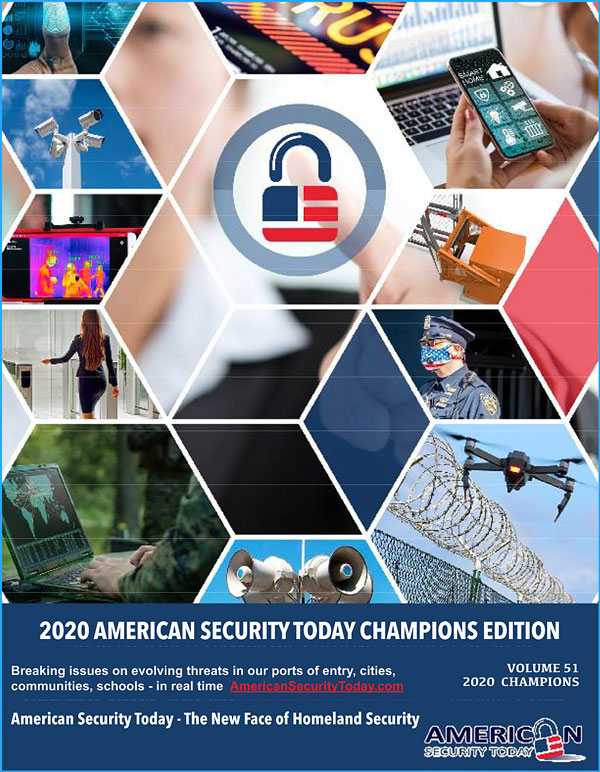 It is your Go-To source throughout the year for ‘The Best of 2020 Products and Services‘ endorsed by American Security Today, and can satisfy your agency’s and organization’s most pressing Homeland Security and Public Safety needs.
It is your Go-To source throughout the year for ‘The Best of 2020 Products and Services‘ endorsed by American Security Today, and can satisfy your agency’s and organization’s most pressing Homeland Security and Public Safety needs.
From Physical Security (Access Control, Critical Infrastructure, Perimeter Protection and Video Surveillance Cameras and Video Management Systems), to IT Security (Cybersecurity, Encryption, Data Storage, Anti-Malware and Networking Security – Just to name a few), the 2020 ‘ASTORS’ CHAMPIONS EDITION has what you need to Detect, Delay, Respond to, and Mitigate today’s real-time threats in our constantly evolving security landscape.
It also includes featured guest editorial pieces from some of the security industry’s most respected leaders, and recognized firms in the 2020 ‘ASTORS’ Awards Program.
-
For a complete list of 2020 ‘ASTORS’ Award Winners, click here.
For more information on All Things American Security Today, and the 2021 ‘ASTORS’ Awards Program, please contact Michael Madsen, AST Publisher at mmadsen@americansecuritytoday.com.
AST strives to meet a 3 STAR trustworthiness rating, based on the following criteria:
- Provides named sources
- Reported by more than one notable outlet
- Includes supporting video, direct statements, or photos













